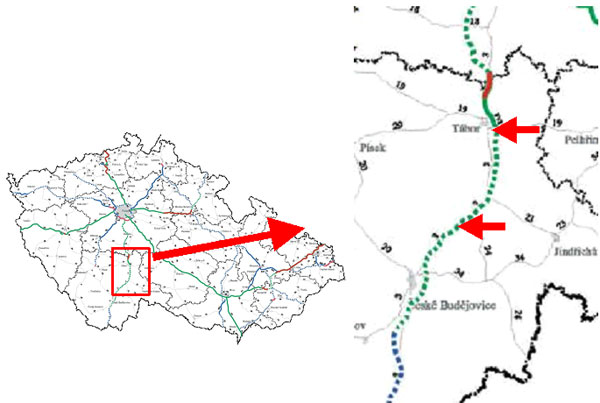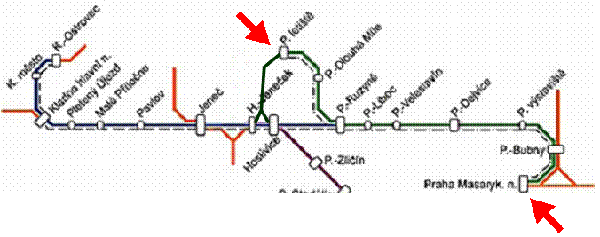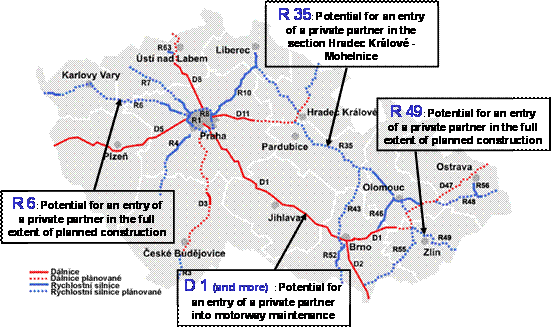PPP Potential in the Czech Infrastructural Transportation Projects

European and Czech Background of Public-Private Partnerships in Transport Infrastructure
One of the main priorities of EU Member countries is to secure preparation and realization of infrastructural transportation projects with the aim to ensure an integrated pan-European transport network and thus provide for the creation of an united internal Market with free movement of goods and services. It concerns both TEN-T projects and other projects on the central and local government levels.
Transportation projects usually involve also tunnels - road and railway tunnels, tunnels under rivers and channels, tunnels in the urban transport, underground systems, etc. With the increasing investment needs of the countries and municipalities we are facing the pressing issue how to secure financing of the projects and how to solve the discrepancy between the ever increasing investment needs of the public sector and the continuing growth of the public sector indebtedness.
The answer is to utilize the financial potential and technological, technical and management experience and skills of the private sector through application of models of Public-Private Partnerships (PPP). From the financial point of view, it means to include private sector financial sources into transportation projects, for a potential benefit of both sides - public and private entities.
The European Commission acknowledges the growing importance a role of PPPs in public investment of Member States. Therefore it aims to clarify the concept of a PPP, specify its policy towards the phenomenon itself and its individual features and disseminate good, proven practice. Its main activities to foster and regulate PPPs can be listed as follows:
-
Commission Interpretative Communication on Concessions under Community Law, published in April 2000, defining individual forms of PPPs incl. concessions;
-
Directives of the European Parliament and of the Council 2004/17/EC, coordinating the procurement procedures of entities operating in the water, energy, transport and postal services sectors, and 2004/18/EC, on the coordination of procedures for the award of public works contracts, public supply contracts and public service contracts. These directives arrange the process of public works and service concessions and the position of concessionaires;
-
EUROSTAT adopted a Decision in February 2004 on the accounting treatment in national accounts of contracts undertaken by government units in the framework of partnerships with non-government units;
-
Green Paper on Public-Private Partnerships and Community Law on Public Contracts and Concessions, presented by the EC in April 2004; the document was subject to public consultation within EU on the future European PPP law. After finished consultation the EC adopted on 15 November 2005 the Communication on PPPs and Community Law on Public Procurement and Concessions. This Communication presents policy options with a view to ensuring effective competition for PPPs without unduly limiting the flexibility needed to design innovative and often complex projects. As main questions were regarded the award of concessions and institutionalised PPPs (i.e. public service undertakings held jointly by both a public and a private partner);
-
It is envisaged that EC will prepare an interpretative document on PPPs in the course of 2006 - 2007.
Main Problems of Czech Transport Infrastructure Development
The Czech Government considers as its basic priorities in the construction of transport infrastructure the need to interconnect the Czech Republic with the European transport network, support for the development of business and transport services in the Czech Republic, and the minimization of harmful environmental impacts. The main targets of the Government in the construction of transport infrastructure can be described as follows:
-
Speeding-up the construction of motorways (540 km in operation, 465 km to be constructed), high-speed roads (310 km in operation, 750 km to be constructed) and rail corridors;
-
Improving the everyday maintenance of road and rail network;
-
Raising the share of rail and inland waterway transport in the transport market;
-
Improvement of infrastructure construction management and efficiency.
In its strive to develop and improve the Czech transport infrastructure to European standards, the Government still faces many problems, e.g.:
-
Need of investment into transport infrastructure approx. € 3 to 4 bn per year to converge with EU-15 - Half the sum effectively available (incl. EU funds);
-
Privatization almost finished - Ad-hoc resources virtually exhausted;
-
Need to improve public budgets - eliminate deficits, reach Maastricht criterion, introduce Euro (2012?)…;
-
Public management of motorway/rail corridor construction inefficient, cost/benefit ratio relatively poor;
-
EU fund utilization meets difficulties - National co-financing often in shortage.
So as to raise necessary financial funds, it is needed to utilize multi-source financing of transport network construction - which is the right place for public-private partnerships (PPP). The government expressed its wish to facilitate the development of public private partnerships (PPPs) in transport.
Considering and assessing various sources of financing, we can see an optimal combination - a multi-source-financing, which contains:
EU Structural and Cohesion funds (based on co-financing principle) + Public sector financial participation (central and local government levels) + Involvement of private sector financial sources (Public-Private Partnerships - PPP, concessions)
The principal benefits of such multi-source financing schemes are:
-
public sector gains access to a range of private sector skills to provide a more efficient and cost-effective service;
-
private sector takes on a range of risks that under traditional public procurement would be borne by the public sector; while it gets a secure ?job? for years, maybe decades;
-
greater efficiency can be generated where a single party is responsible for design, construction, management and financing as a part of an integrated package.
Co-utilizing EU funds and private financing (PPP)
Can we utilize the EU co-financing directly together with private financing (PPP) in the concrete infrastructural project?
EU countries were able to combine EU funds and PPPs (Portugal, Greece etc.), but private funds did not replace national co-financing. The combination of both factors was relatively rare, because:
-
Combination leads to time delays as it is needed to link EC decisions with a relative complex conclusion of a concession agreement;
-
Using a PPP scheme is more costly for public sector because of expenses on material and legal consulting;
-
A revenue making PPP project leads to a reduction of EU contribution;
-
EU contribution typically takes place only after the completion of the whole project, which may raise the cost of securing funds by the private partner.
Generally, combining of EU funds and private financing is not excluded, but can be limited only to the cases when it brings strong synergic effects. Also more questions are still to be solved:
A ?public? or ?private? share of EU fund support for a PPP? (the latter discriminates the project vis-à-vis purely public investment)
Clear solution of Special Purpose Vehicle:
-
What accounting and tax regimes can be used? Public or private? (When repaying private investment, public bodies in fact pay private taxes enhanced by a complex interest rate…)
-
What treatment with unique infrastructure in case of bankruptcy?
-
How to assess public aid in case of a (typically monopolistic) PPP?
Stakeholders in PPP projects need to see EU legislation clarified to provide legal certainty, and a clearer insight into the real Value for Money for both partners.
Institutional and Regulatory Framework of PPPs in the Czech Republic
What is the current situation in the Czech Republic? Can we apply the principles of PPP to our infrastructural transportation projects?
The answer is ?YES?. Czechia possesses a sufficient institutional and regulatory framework. The legislation in force in Czechia concerning PPPs contains the following Acts:
The Act No. 139/2006 Coll. on Concession Contracts and Concession Procedures (Concessions Act);
The Act No. 137/2006 Coll. on Public Contracts.
Main stakeholders in the sphere of public regulation and general interest are as follows:
Ministry for Regional Development
As the central body of state administration with powers in regional and investment policy, it is responsible for legislature of PPP, concession procedures and concession contracts. It also maintains the Concession Contracts Register.
Ministry of Finance
The Ministry of Finance is, according to the Concessions Act, responsible for budget supervision. Prior to the conclusion or a change of a concession contract by a public body, an opinion of the Ministry of Finance has to be asked for. This opinion constitutes a condition for the conclusion of the contract. The MoF therefore acts as a financial regulator.
Office for Protection of Competition
The Competition Office acts as a supervisor of tenders governed by the Concessions Act (and also the Act on Public Contracts). It decides whether the contracting entity has complied with this Act; imposes remedies and fines for administrative offences.
PPP Centrum
PPP Centrum (PPP Centre of the Czech Republic) is the main methodological body in the Czech PPP system. It is governed by the Ministry of Finance and its commitment is to:
-
Successfully implement PPP projects in the Czech Republic;
-
Help to set and ensure best practice in developing, procuring and appraisal of PPPs;
-
Ensure sophisticated discussion and an exchange of information and knowledge obtained in realization of PPPs;
-
Minimize risks resulting from realization of PPP projects for public sector;
-
Serve all parts of the public sector in the whole preparation process of PPPs;
-
Ensure transparency and set up ethical standards;
-
Develop our professional capacity and serve as a centre of knowledge for the area of PPP in the Czech Republic.
Association for PPP
The Association for PPP in the Czech Republic was established in 2004 to support investments and services by means of PPP in the Czech Republic. It cooperates in drafting regulations and rules, helps to ensure transparent principles of PPP investment and strengthen general confidence in effective forms of the public and private sector co-operation.
Sectoral Ministries (incl. Ministry of Transport)
Regions & Municipalities
Act in preparation and contracting of specific PPP projects
PPP Projects in the Sphere of Transportation
The Czech Ministry of Transport prepared a solid pipeline of potential PPP transportation projects. The most advanced of them are:
D3 motorway section Tábor - Bošilec (Southern Bohemia).

Fig. 1: D3 motorway section Tábor - Bošilec
Main features:
-
A 30 km part of a new motorway D 3 Praha - České Budějovice; a component of a trans-continent route linking Scandinavia with Austria and Italy (E 55, TEN-T)
-
Investment cost: approx. € 380 million
-
A DBFO project with 6 years of construction and 30 years of operation before transfer to the Government
-
Pattern of risk sharing: Private partner - construction and availability risk; Public sector - project and demand risk
-
Status: High stage of project schedule; Introductory Audit completed, Realization Model near to completion
-
Construction: 2008 - 2010
Questions to Resume:
-
Revision of Value for Money computations - Has anything important changed?
-
Shadow toll or availability fee? Or both?
-
Some extras to the general road toll concept for the users?
-
Extending the scope: Tábor - České Budějovice, or all planned sections of D 3?
-
Including EU funds and/or EIB loans - what is really possible?
-
Invite adjacent businesses, real-estate, include public lands etc. to form a pro-efficiency alliance?
AIRCON Project

Fig. 2: AirCon Project
Main features:
-
Improvement, double-tracking, electrification and new construction of a 19 km rail line between the centre of Prague and Prague International Airport (Ruzyně)
-
Essential transport solution for the dynamically growing airport (doubling of passengers to 11.5 million during last five years); extension to the Kladno satellite town in the vicinity
-
Investment cost: approx. € 550 million
-
A BOT or DBFO project - a long-term concession agreement for construction, operation and maintenance of the track; a hired private-law rail operator capable to take over also public service obligation service for Prague - Kladno line
-
Pattern of risk sharing: Private partner - construction and availability risk; Shared demand risk
-
Status: Verification and interest reconciliation phase
-
Construction: 2009 - 2012
Questions to Resume:
-
Verification of chosen route: reconciliation of standpoints with Prague City and Praha 6 District needed. If a compromise cannot be reached, re-routing of the project inevitable
-
Alignment to the overall Prague rail junction project
-
Revision of Value for Money computations - Has anything important changed?
-
Public service obligation subsidy - only regional, or also airport traffic?
-
Extending the scope: also to Prague - Kladno regional transport project?
-
Including EU funds and/or EIB loans - what is really possible?
-
Invite adjacent businesses, real-estate, include public lands etc. to form a pro-efficiency alliance?
Other Czech road projects are also being considered for PPP projects.

Fig. 3: Further potential PPP projects in the Czech transport infrastructure
More possibilities are now also under discussion:
-
R 1 - outer circuit of Prague City - eastern part (to be realized in 2009 - 2013;
-
total cost approx. 600 million EUR)
-
R 52 - Pohořelice - Mikulov
-
R 55 - Břeclav - Kroměříž
Potential of Rail PPP Projects
Rail projects are more tending to long term returns - PPP projects are therefore more vulnerable. Real estate development is possible especially in stations and logistic areas, and also where rail borders with large potential developments. Anywhere, public service obligation extent (in passenger transportation ) is to be solved, as well as the linkage to road and/or urban transport networks.
The following projects are also under discussion as potential PPP projects:
-
1st operational section of Metro line ?D? Náměstí míru - Nové Dvory (completion 2016; total cost approx. 1,2 bn EUR)
-
Extension of Metro line ?A? Dejvická - Prague International Airport (completion 2017; total cost approx. 1.4 bn EUR).
Other Potential Spheres of PPP Projects in Transport in the Czech Republic
A relatively low capital demand is typical for many of these spheres. In most cases it would be a PPP for service provision rather than a classical investment/repayment cycle. This sort of potential PPPs may concern e.g.:
-
Public logistics and intermodal terminals
-
Road and urban toll systems
-
Applications on Galileo, GPS satellite systems
-
Intelligent Transport Systems (such as motorway traffic flow regulation)
-
Road and track maintenance
-
Private management of public infrastructure investment (using public funds).
The main advantage of such projects consists in an advanced technological concept linked with efficient private management.
General Problems of PPPs in Transport
General problems of PPP concept in transport consist especially in:
-
Efficient protection of public interest - the public partner remains often weaker, does not use legal advice at the level commensurate to the size of the project, and also influences of political cycle may prevail. This may not only bring losses to the taxpayer, but may discredit also the original idea of a PPP itself
-
Transparent and sustainable structure of PPP and clear balance of public payments/repayments - it must be perfectly clear, what will be the investment and share of both partners, how will the property structure develop upon time and what will be the general cost covered by the public partner. This all should be found as early as in the phase of a Public Sector Comparator
-
Clear conditions of service quality, claims, sanctions for non-compliance etc. - the structure of risk sharing and the responsibility stemming thereof should be clarified and embodied in the concession contract
-
Functional dispute prevention and resolution, conditions for contract update, for termination of partnership etc. - this all must be part of the concession contract
-
Demand and return conditions of a PPP project (especially the payable traffic) must be always impartially and independently verified! - PPP is no place for fans and naïve optimists
-
PPP for services (without private investment) are possible almost everywhere, only efficiency of solution matters!
Conclusion
To sum up, we can stick to the following clear statements:
-
The existing system of transport infrastructure financing in the Czech Republic is unsustainable - changes must be made and new resources searched for
-
PPP is an interesting and useful concept especially for the transport industry
-
PPP can be generally used where the revenue is sufficient for the reproduction of private capital, the quality of services can be considerably raised and a sustainable concept of public repayment of the investment exists
-
The most successful PPPs can emerge in new sections of motorways and high speed roads and in rail station developments
-
Demand and return conditions of a PPP project must be in all cases verified by impartial financial models
-
Public sector interest must get a good contractual protection.